Please join me in welcoming Elisa Wilson as a guest blogger today as she gives you a glimpse into her life as a pattern designer. Share your favourite beginner’s quilting tip for a chance to win a free pattern and template of your choice.
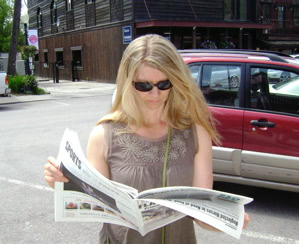
I have a secret life. Most of my friends and acquaintances don’t know what I do. When I meet someone for the first time, this is how the conversation goes:
Them: "Do you work?"
Me: "Yes, I have a business. I design quilts and produce patterns and acrylic templates for quilters."
Them: Blank stare, long pause. "Oh, you make quilts."
Me: "No, I make patterns and sell them to quilters who make the quilts."
Them: "Who buys them?"
Me: "Well, I sell mostly to quilt shops across the US and to distributors who sell to quilt shops."
Then another person walks up and Them introduces me: "This lady makes quilts."
Me: Sigh. "Yes, I make quilts."
For a pattern designer, life revolves around market (it is a BIG deal for us). International Quilt Market is held twice a year. In the spring it moves around to different locations and in the fall it is always in Houston. At market you will find many different pattern designers, fabric companies, publishers of magazines and quilt books, thread companies, sewing machine manufacturers and much more.
Market is about what is NEW. It is your chance to show everyone your newest creations. Immediately after market is over, you have to start on the new NEW and have it ready in time for the next market.
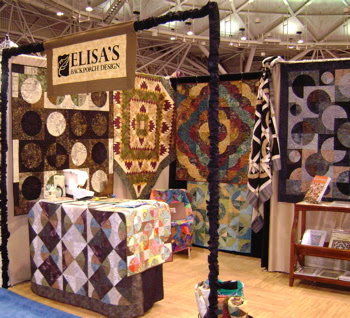
So what do I really do all day?
After my breakfast and morning workout I am on the computer. Computer work takes up the majority of my day. I am sending emails, posting blogs, marketing, taking online classes, designing, writing patterns and coordinating with graphic designers, printers and shop owners. Some days I even get to sew!
I truly enjoy the design the process. This is how it usually goes:
First, I receive fabric from one of the fabric companies I work with.
Then I sort through the fabric. This time there are about 30 different colors. Immediately I pull out any fabric that does not appeal to me. Fortunately there are only about 6 I do not like in this bunch. The rest definitely speak to me.
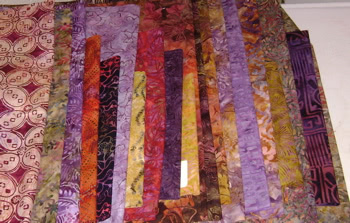
Next I divide the fabric into colors. I make piles of colors that seem to be the same (greens in one pile, yellows in another, etc.). Then I re-divide the fabric into lights, mediums, and darks. I re-arrange it many times.
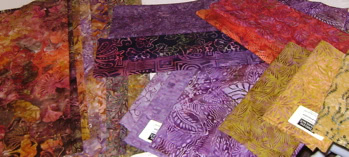
I am handling the fabric, getting familiar with the colors and patterns. I usually let it sit on the dining room table and look at it during the day. Depending upon the deadline it can sit there for a few days or a few weeks.
I begin to get a few ideas and then I go to my EQ (Electric Quilt) and play around with different blocks.
Will this be an easy pattern or something more complicated? How many fabrics do I need to use? Does it have to be a certain size? Will I be producing the pattern or am I writing it for a fabric company? Playing on EQ can take days.
Once I have a few ideas I begin to make test blocks. It is surprising that what looks good on EQ does not always translate to good in fabric. I sew a few test blocks, try a different fabric, arrange the blocks, go back to EQ, re-arrange the blocks.
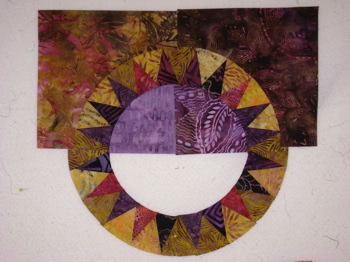
Then I write down how to make the blocks. Make a few more blocks to see if my instructions really make sense. A lot of back and forth goes on. More questions: Is it a good pattern? Is it different? Does it showcase the fabric? Who will this appeal to? Is it too boring or too challenging?
Every quilt needs a name. My husband is super good at coming up with names. He writes down a bunch of names, just letting his imagination go and writing anything that comes to mind. We can get a good chuckle during the word play on names.
After the quilt top is made I have to quilt and bind it. I love the quilting but dislike the binding. I then send it off to the photographer to get its picture taken for the pattern cover. While the photographer is working, I’m writing the pattern instructions. The pattern is proof read and tested. As soon as I get the quilt photo, the graphic designer and I create the pattern cover. The instructions and cover design are sent to the printer. Everything is printed and assembled into bags.
Whew! That’s a lot of work. I usually have three or four patterns going on in different stages at one time. I work about 40 hours a week and I juggle a lot of hats.
So my secret life is out. Are you surprised? How does it sound to you? Is it what you thought it would be? I would love to hear your comments and questions.
I invite you to join me as I chronicle my life as as a designer and my adventures in the awesome Montana wilderness that is my home at Seams Sew Crazy or on Facebook. Visit my online shop, Elisa’s Backporch Design, to see my patterns, templates and video tutorials.
Give-Away
I am offering a drawing for a free pattern and template of your choice. Anybody who makes a comment is entered.

To enter the give-away: Leave a comment below sharing your favourite beginner’s quilting tip. Give-away ends September 8, 2010. Winner will be chosen randomly.
This contest is now closed. Congrats to #61 Brigitte!
Please continue to share your favourite quilting tips. These are awesome!

Leave a Reply